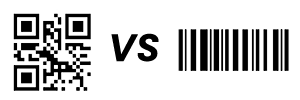
QR Code vs Barcode
How does QR Code Differ from Barcode?
| BARCODE | QR Code | |
|---|---|---|
| Matrix Type | It is two types: 1 dimensional and 2 dimensional | It is only one type: 2 dimensional |
| Representation | A vertical arrangement of parallel lines and numbers of varying widths | They consist of black and white squares in various sizes or a rectangle grid |
| Purpose | Barcodes can store product details and transmit text, images, contacts etc. | QR codes can store a URL, text string, or phone number and transmit data associated with consumers or consumer products. |
| Mainly used in | It can be used in many industries, from business and manufacturing to healthcare, tracking all purchased items; in hospitals for tracking the records of patients, in rental car businesses and for tracking airline luggage and mail. | It is used in supermarkets, hospitals, and cinemas for the transfer of data, such as sharing contacts, photos, videos, and other documents. |
| Scan Ability | Barcode can be scanned vertically. | QR code Scanned both vertically and horizontally |
| Visual Representation |  |
 |
Barcode/QR code: Purpose and Introduction
Barcode is an image that is in a square or rectangular shape and consists of parallel black lines that are used in retail store items, identification cards, postal mail, and particular product. Barcodes can help you maintain accurate information about inventory products and accounting processes in many shops and companies. They can also be used to track inventories and improve supply chain efficiency in warehouses.
QR Codes use a two-dimensional structure that contains black modules that are arranged in a square pattern, which means they can be read both horizontally and vertically. The most common things held in QR codes are website URLs, phone numbers, plain text, email address and other alphanumeric data up to 4296 characters. QR codes have become extremely popular in areas such as consumer advertising, code payments, website logins, and data encryption, amongst others.
Which is Better, QR Code or Barcode?
A QR code is faster to scan and holds more data than a barcode. QR code has correction abilities when it is damaged, but it can still be read by a scanner in comparison to a barcode.
Barcodes on items we purchase are not unique, which means if you have three of the same item, they will have the same barcode, and this will be a problem if you want to track assets individually. But QR codes can be used to give a unique identity to assets.
If you use a smart device to scan regular barcodes, you will need to have a high-quality label printer, but QR codes are much less dependent and can be easily scanned with tablets and smartphones.